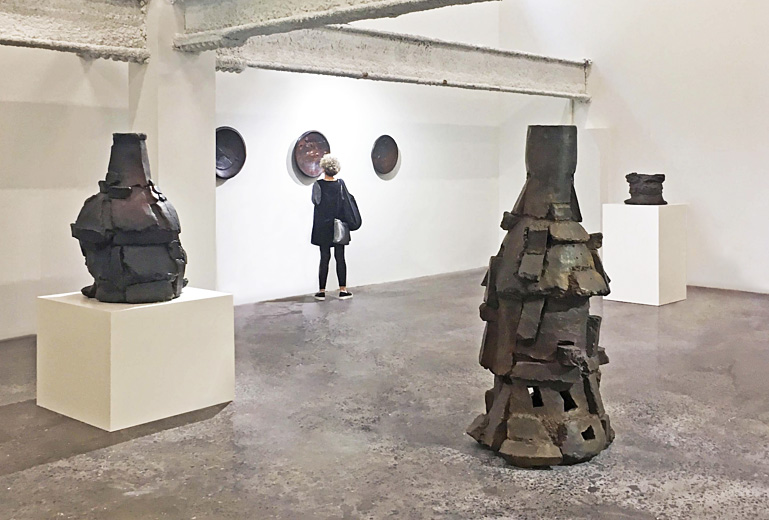Peter Voulkos: Merging Ceramic and Bronze
 Peter Voulkos exhibit on view at Burning in Water.
Peter Voulkos exhibit on view at Burning in Water. Photograph courtesy of Burning in Water.
Burning in Water recently unveiled a solo retrospective exhibition of sculptures by Peter Voulkos spotlighting his significant works in both bronze and ceramics.
Peter Voulkos: Stacks is the inaugural exhibition to commemorate the gallery’s new two-level exhibition space. Made possibly by a collaboration between the artist’s estate and Artworks Foundry of Berkeley, the collection features 10 monumental large-scale examples of the artist’s renowned “stacks” works, cast from some of the artist’s most important ceramic sculptures.
Voulkos is considered a seminal figure in the development of contemporary ceramic art in America. As both a working artist and educator, Voulkos was instrumental in unleashing a transformative wave of creativity in clay and bronze, and his influence can be seen in many contemporary artists today.
According to curator and scholar of modern and contemporary art, Elissa Auther, “The rupture Voulkos enacted with his abstract, non-functional, ceramic sculptures in the mid to late 1950s was, like all ruptures in the history of art, a singular act. Voulkos owns his breakthrough in ceramics, just as Pollock owns his drip technique.”
Born in Bozeman, Montana in 1924, Voulkos began working with clay in 1949 as an undergraduate, graduating with an MFA in 1952. Soon after, he moved to New York entered the social sphere of artists in Greenwich Village including Jackson Pollock, Clyfford Still, Robert Motherwell and Philip Guston. He later moved to Los Angeles to become chairman of Ceramics department at the Otis Institute of Art.
Although he is known for both mediums, Voulkos’ experience with bronze predated his work with clay. He first began casting bronze in 1942 for the Western Foundry Company, where he fabricated engine molds for American Liberty Ships, and was profoundly impacted by this experience. Inspired by his proximity to the robust Northern California foundries, and his desire to create larger scale works led him to focus almost exclusively on bronze, reserving ceramics for teaching and the raucous, anarchic performances in which he fashioned large ceramic works at universities across the country.
For the rest of his career, Voulkos modulated between his interests in clay and bronze, and between 1960 and 1962, he poured more than 10,000 pounds of bronze. During his time at Garbanzo Foundry in the early 1960s, Auther noted, “The foundry and its fiery moment of the white-hot pour became the center of a new bronze culture, no less than a cult. Many gifted artists and students came around to watch the bronze pour and participate in the party, which was part of the work atmosphere.”
This retrospective represents the serendipitous merging of Voulkos’ decades-long engagements with both bronze and ceramics.
“There’s a lot of difference between clay and a five hundred pound casting,” stated Voulkos. “But my ideas, you know, still come from feeding back on the clay when I first touched it, and everything that happened between then and now.”
Resources:
Also in this Issue:
- Phenomenal Nature: Mukherjee Retrospective opens at the Met
- Custom Copper Designs with a Twist
- Coast Chimes: The Signature Sound of Copper
- A.E. Seaman Mineral Museum: Preserving A Monumental Copper Discovery for Generations
- Peter Voulkos: Merging Ceramic and Bronze
